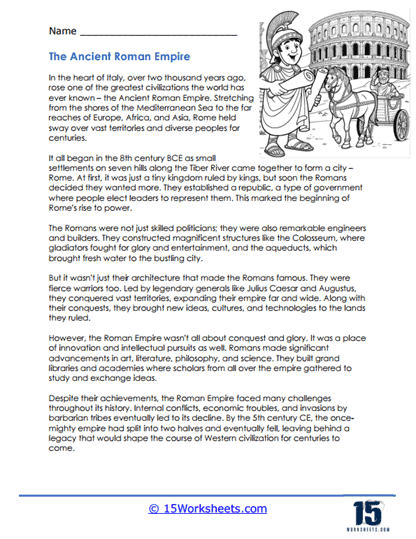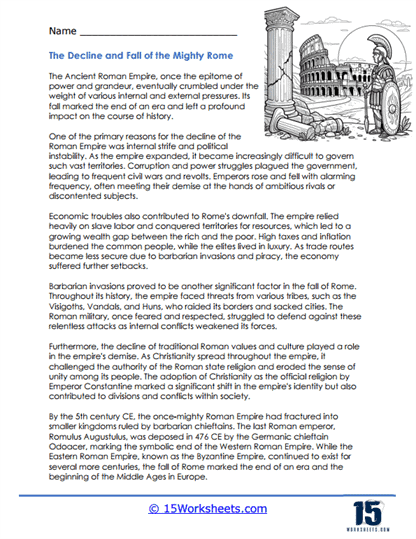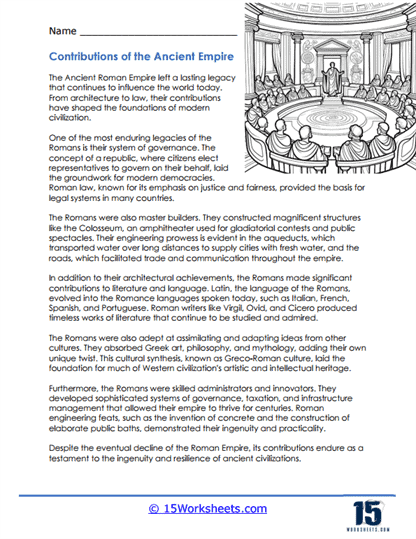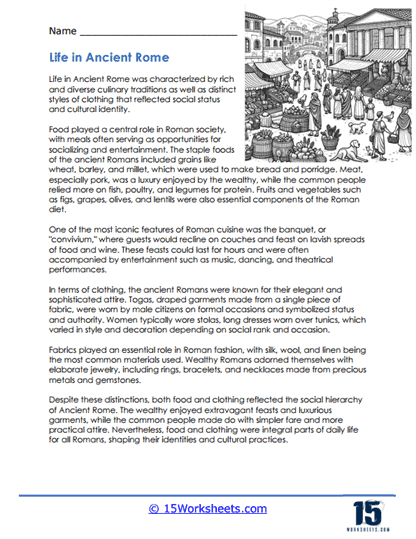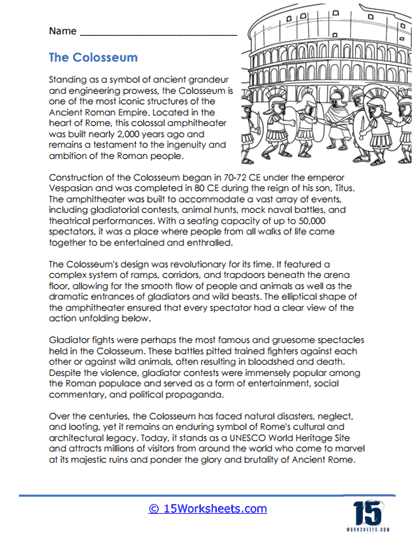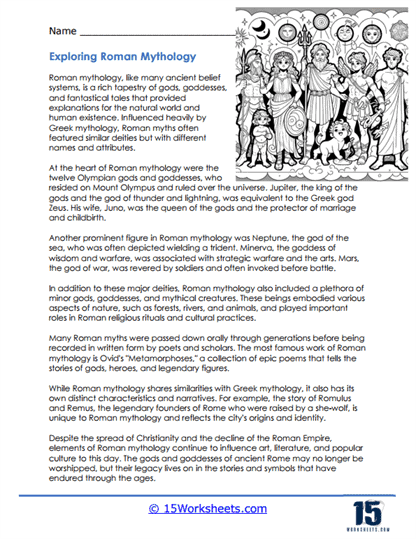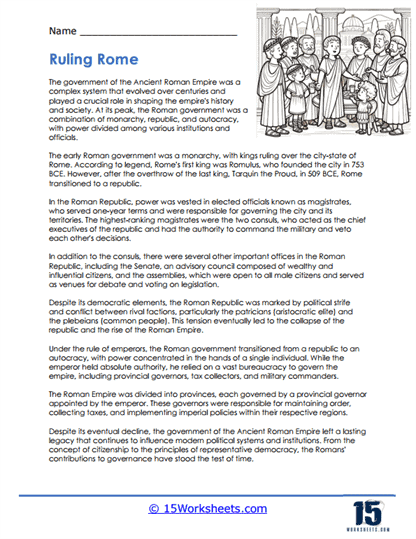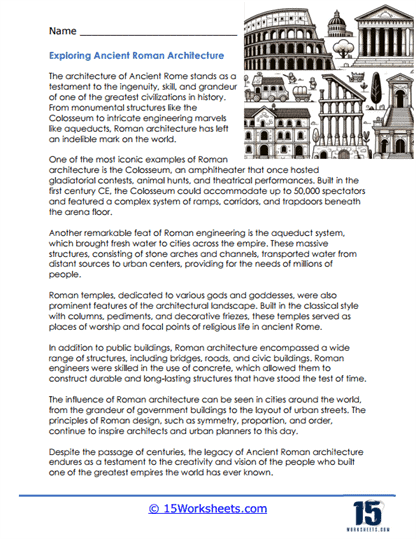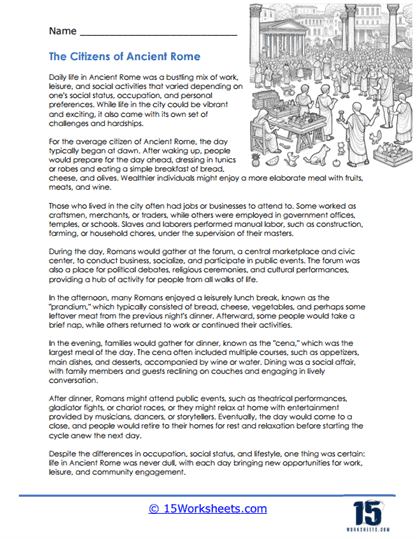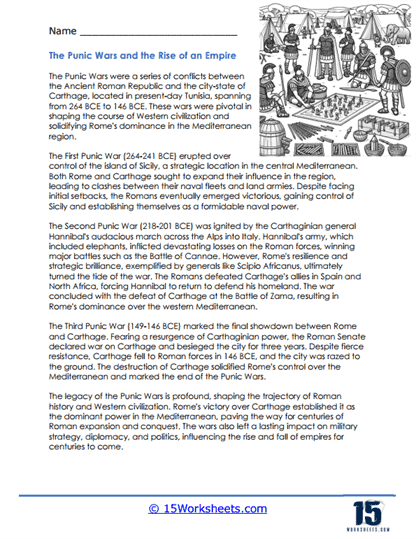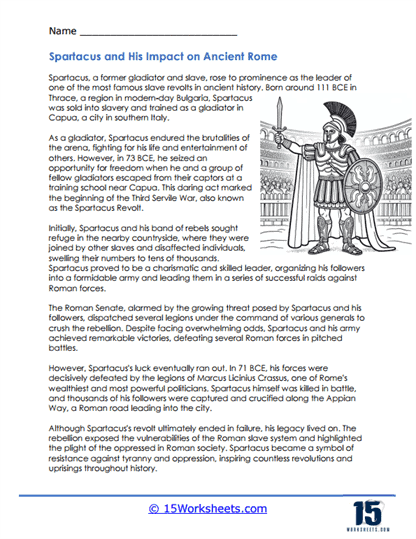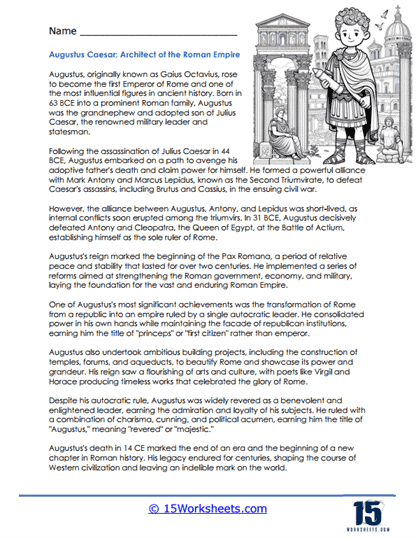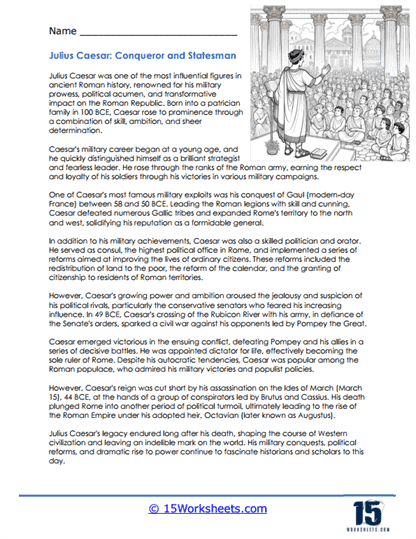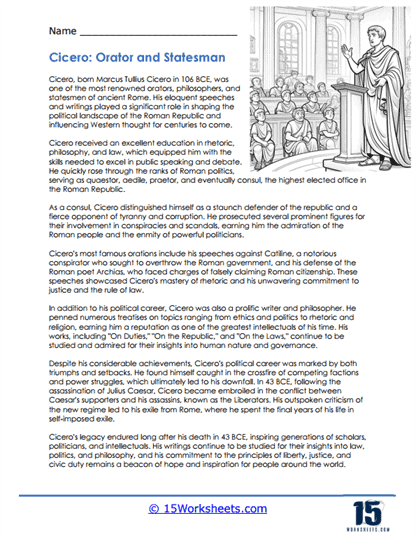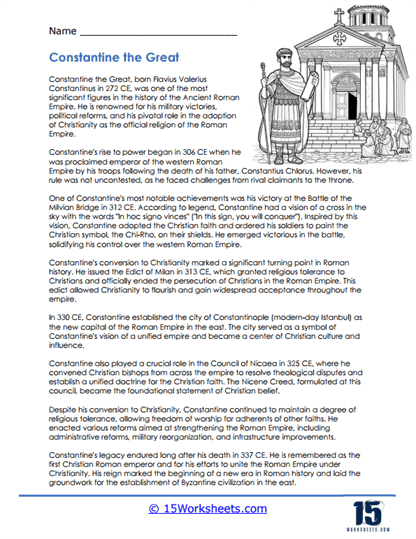Ancient Rome Worksheets
About These 15 Worksheets
These worksheets were created to help introduce students to the vast and intricate history of Ancient Rome. These worksheets span across various activities that challenge and engage students to solidify their knowledge and understanding of Roman history, culture, governance, engineering, military prowess, and daily life. These exercises cater to a range of learning styles and often include a mix of reading passages, comprehension questions, creative tasks, and critical thinking challenges.
By utilizing these worksheets, students not only absorb facts and dates but also develop a multi-dimensional understanding of the broader implications of Roman history and its enduring influence on the world today. Through these various exercises, learners are equipped with the tools to think critically, engage creatively, and form reasoned conclusions about the past and its connection to the present.
The Types of Exercises
Spanning Rome’s legendary birth and its towering monuments, the collection opens with sweeping overviews such as “The Roman Legacy,” “Foundations of Roman Glory,” “The Colosseum’s Tale,” and “Echoes of Empire.” Students trace the city’s rise along the Tiber, marvel at aqueducts and roads, and discover why the Colosseum still defines crowd-pleasing architecture. These passages ground learners in the big picture-how republican ideals, engineering genius and Latin literature became cornerstones of Western civilization-while guiding them to connect ancient innovations with today’s governments, skylines and languages.
Next come vivid narratives of power, conflict and charisma. Biographical worksheets-“Caesar: Path to Power,” “Augustus’ Ascent,” “Cicero’s Legacy,” and “Constantine’s Legacy“-show how shrewd leaders reshaped a republic into an empire, launched the Pax Romana, defended republican virtue with soaring oratory, and finally tied imperial destiny to Christianity. Beside them, “Punic Conflicts” and “The Story of Spartacus” plunge readers into Hannibal’s daring Alpine march and the slave-army that rattled Rome’s legions, teaching strategy, courage and the costs of expansion. Together these texts invite students to weigh ambition, ideology and faith in moments when a single choice-crossing the Rubicon, issuing the Edict of Milan-changed world history.
Finally, everyday Rome comes alive. “Togas and Tastes,” “Roman Rendezvous,” and “Deities and Legends” explore social class through food, fashion and mythology, while “Governing Rome” and “Rome’s Descent” track the evolution-then unraveling-of Rome’s political machinery. Students step into morning markets, senate debates and twilight banquets, meeting Jupiter in epic myths and confronting the hard lessons of civic neglect. Throughout the set, multiple-choice and inference questions sharpen comprehension, but the real reward is perspective: by comparing ancient routines with modern ones, readers see that roads, laws and even lunch menus still echo with Roman voices.
The Benefits of These Worksheets
Reinforcement of Facts – By engaging with the worksheets, students reinforce their memory of significant events, figures, and terms associated with Ancient Rome.
Contextual Understanding – Worksheets help students place historical events in context, which is essential for understanding the cause-and-effect relationships that shaped Roman history.
Development of Critical Thinking – Exercises that require analysis, such as essay questions or debates, promote critical thinking skills, allowing students to evaluate the relevance and impact of Roman culture and politics on today’s world.
Improved Literacy Skills – Reading and writing activities boost literacy. As students read about Ancient Rome and write their answers or essays, they improve their reading comprehension and writing proficiency.
Cultural Appreciation – Through the study of art, architecture, and daily Roman life, students gain an appreciation for the cultural achievements of Ancient Rome and their lasting legacy.
Engaged Learning – Interactive activities like role-playing or simulation games make learning about Ancient Rome an active and engaging experience, which can lead to a more profound and lasting understanding of the subject. Ancient Rome worksheets often intersect with geography, politics, economics, and art, providing students with a holistic educational experience that transcends the confines of history alone.
What Was The Ancient Roman Civilization?
Ancient Rome was a classical civilization that emerged on the Italian Peninsula as early as the 8th century BC. Initially a small town on the banks of the Tiber River, Rome grew in power and stature to ultimately dominate the entire Mediterranean region and much of Western Europe. Its civilization transitioned from a Monarchy (circa 753–509 BC), to a Republican form of government (509-27 BC), and later to an autocratic empire (27 BC–AD 476 in the west and until AD 1453 in the east with the fall of Constantinople).
Government and Society
Rome’s republican period established a form of government that left a lasting legacy on the Western political landscape. The Republic was characterized by a system of checks and balances, a division of powers, and a complex web of political institutions, including the Senate, the Assemblies, and the Magistrates. Roman law, known for its principles of equity and fairness, became a cornerstone for Western legal systems.
Roman society was hierarchical, with distinctions between the freeborn (patricians and plebeians), the freed (libertini), and slaves. The family unit, headed by the paterfamilias, was the foundation of Roman social life. Public life was marked by civic duty; Roman citizens engaged actively in political discourse and public affairs.
Economy
The economy of Ancient Rome was vast and complex, featuring diverse agricultural practices, extensive trade networks both within the empire and with foreign lands, and a variety of manufacturing industries. Rome’s economic power was bolstered by its use of coinage and sophisticated financial instruments.
Military
Rome’s military prowess was unmatched in the ancient world, responsible for the vast expansion and maintenance of the empire. The legions, well-trained and disciplined, were crucial in conquering and securing territories. Roman military strategies, engineering skills in building roads, forts, and aqueducts, and the integration of conquered peoples into the army were innovative aspects that contributed to its long-standing dominance.
Culture and Religion
Roman culture was heavily influenced by the Hellenistic world, particularly Greece. This is evident in Roman art, architecture, literature, and religion. The Romans were adept at absorbing and assimilating the best of the cultures within their empire, creating a cosmopolitan and diverse cultural milieu.
Religion in Rome was initially polytheistic, worshiping a pantheon of gods similar to the Greeks, but with distinct Roman names and attributes. Over time, the introduction of Eastern religions, mystery cults, and eventually the rise of Christianity (which became the state religion in the 4th century AD) dramatically transformed the religious landscape of Rome.
Contributions to Humanity
Legal System
The Roman legal system laid the groundwork for modern jurisprudence, establishing concepts that have become the cornerstone of contemporary law. The Romans were pioneers in developing a codified system that articulated the rights of individuals, setting a standard for justice that transcended the empire’s borders. Central to this system was the presumption of innocence, an idea that has carried through to the present day as a fundamental aspect of fair trials worldwide. These Roman principles have been embedded in international law and are still upheld in the constitutions and courts of numerous countries, symbolizing a lasting legacy that continues to uphold the rights and liberties of people across the globe.
Engineering and Architecture
Roman feats in engineering and architecture reflect a civilization that was not only advanced for its time but visionary in its enduring influence. With an unparalleled knack for construction, Romans built an infrastructure network of roads, bridges, and aqueducts, many of which have remarkably withstood the test of time, attesting to their engineering prowess. Architectural innovations such as the development of the arch, vault, and concrete facilitated the creation of awe-inspiring structures like the Colosseum, which remains a testament to their ingenuity. The Pantheon, with its unreinforced concrete dome, stands as a monumental achievement in architecture, showcasing the enduring nature of Roman design and construction expertise.
Language
Latin, the lingua franca of the Roman Empire, sowed the seeds for the Romance languages of today. Its legacy is evident in the tongues spoken throughout Europe and various parts of the world, including Italian, French, Spanish, Portuguese, and Romanian. Furthermore, Latin has permeated the English language, enriching its vocabulary with a wealth of terms, particularly in specialized fields such as law, medicine, and the sciences. Latin phrases and terminologies continue to be used in these domains, underscoring the language’s timeless relevance.
Government
The concept of a republic that emerged from Rome has had a profound impact on the governance structures of modern democracies. The Roman system of checks and balances, the separation of powers, and the notion of representative governance have been integral to the development of political thought and organization. These Roman contributions have inspired many of the democratic principles we value today, and they continue to serve as a blueprint for political systems around the world, reinforcing Rome’s enduring imprint on modern governance.
Literature and Arts
In literature and the arts, the Romans have left an indelible mark. Works such as Virgil’s “Aeneid” have been immortalized in the Western literary canon, providing both a narrative of Rome’s mythic origins and a cultural touchstone that has inspired authors through the centuries. The historical accounts of writers like Livy and Tacitus offer invaluable insights into the Roman world, influencing historiography and the study of the past. In the realm of art, Roman sculptures and frescoes have inspired countless generations of artists, setting standards for artistic excellence that endure in contemporary art and education.
Urban Planning and Public Works
The systematic layout of Roman cities, characterized by a central forum surrounded by a grid of straight streets, showcased an early form of urban planning. Their innovative public works, which included advanced sanitation systems, public baths, and extensive water supply systems, laid the groundwork for modern city planning. These contributions reveal a sophisticated understanding of urban living and public health that has informed the development of cities throughout subsequent millennia.
Military Tactics
In military science, the organizational skills and strategic acumen of the Roman army have been subjects of study in military academies across the world. The discipline and tactical formations developed by Roman military leaders, such as the use of legions, the manipulation of geography, and the integration of various military units, have informed the evolution of military strategy and are still revered for their effectiveness and efficiency.
Cultural Syncretism
The Roman practice of cultural syncretism – incorporating the gods, beliefs, and practices of other cultures into their own – demonstrated a degree of cultural adaptability and tolerance that was ahead of its time. This approach fostered a diverse and vibrant society, enabling Rome to integrate a wide array of traditions and customs. The legacy of Roman cultural syncretism is a testament to the empire’s ability to absorb and respect the plurality of cultures within its vast expanse, which has in many ways laid the foundation for the multicultural societies we see today. The Roman embrace of diversity has taught us the value of blending ideas and traditions to create rich and enduring cultural tapestries.

